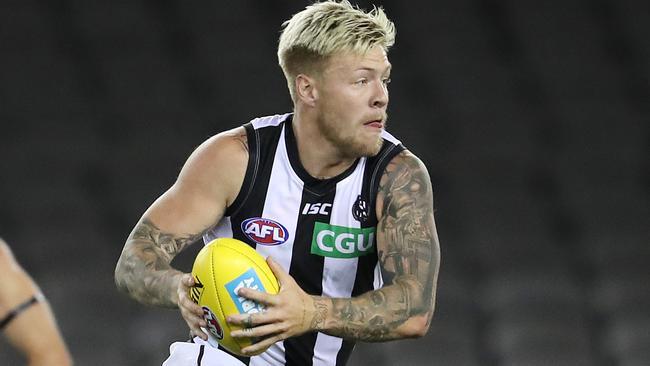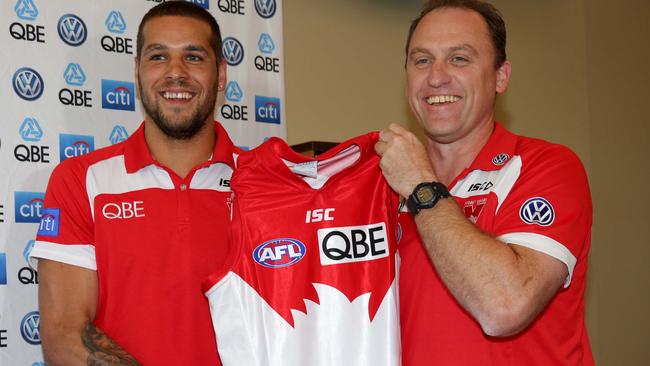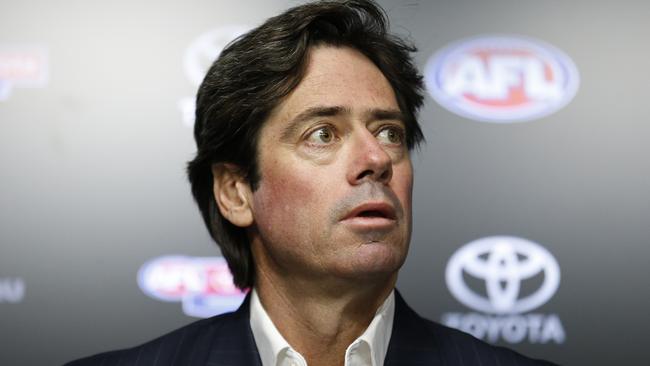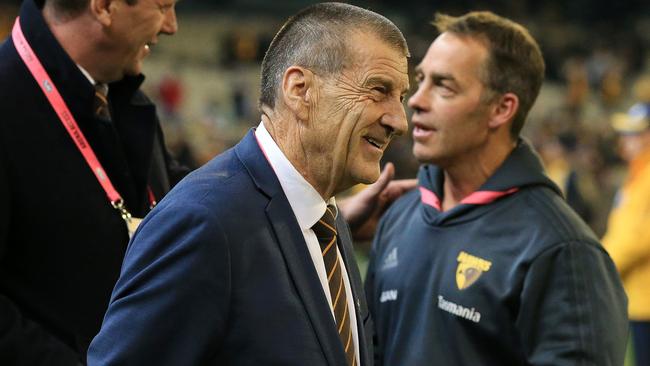Long-term mega contracts could be thing of the past as list guru Chris Pelchen unveils plan to solve AFL’s list issues
AFL player agents fear the uncertainty surrounding future salary cap sizes – and the financial squeeze on clubs – will put an end to long-term mega deals, with an out-of-contract Collingwood star looming as an important early test case.

AFL
Don't miss out on the headlines from AFL. Followed categories will be added to My News.
Buddy Franklin and Dustin Martin-style blockbuster contracts – and long-term deals of four or more years – are likely to be binned in favour of shorter-term arrangements as the financial tsunami sweeps the AFL.
Out-of-contract Collingwood superstar Jordan De Goey looms as an important early test case of footy’s changed landscape post the coronavirus crisis.
De Goey, 24, would have been able to command a tenure similar to the seven years Collingwood gave ruckman Brodie Grundy earlier this year.
Stream over 50 sports on-demand with KAYO SPORTS on your TV, computer, mobile or tablet. Just $25/month, no lock-in contract. Get your 14-day free trial and start streaming instantly >

But player agents say the uncertainty surrounding future salary cap sizes – and the financial squeeze on clubs – will result in fewer mega deals.
Managers warn the hardest hit group of players will be middle tier footballers seeking the security of three or four year deals.
It comes as list guru Chris Pelchen forecast a solution to the AFL’s radical plan to cut list sizes back to 35 next year, which would cost almost 200 current players their job.
Pelchen, a highly-rated former list manager at Hawthorn, Port Adelaide and St Kilda, has called on the AFL to allow clubs to have “active” and “inactive” lists.
It would provide greater player movement in-season and secure the futures of those players in jeopardy, with inactive players receiving substantially less money.
The plan would also suit the competition’s shift to shorter-term contracts – with some deals fixed for six to eight weeks for those changing clubs during the season.
"We've seen in the last decade, and in particular the last five years, franchise players – and now it is spreading a bit deeper than just franchise players – getting longer-term contracts," Pelchen said.
"Four and five year contracts are not an anomaly any more."
"I think that will flip.
"Go back 10 or 15 years, and not many people were getting four or five year contracts.
"You would still have the opportunity to have those long-term contracts. But I think you will find clubs are starting to look at shorter-term contracts."

Pelchen said the best way to safeguard players against a list squeeze – including ‘project’ players and mature-aged recruits – was to change list structures.
"I am a strong supporter of what was a planned initiative when the draft was first prepared in the mid 1980s – I was on the original draft committee – and that was to have active and inactive lists," Pelchen said.
"This is the perfect opportunity. It means players won't be lost to the system when the AFL cuts back list sizes."
The plan involves each club having an active list of 35 players, who are eligible to play AFL in any given week, as well as an inactive list of 10, who can play in the club's secondary team.
Clubs would have unlimited opportunities to move players between their active to inactive lists.
Any player on an inactive list could be poached by a rival club during the home-and-away season, if that player was willing to leave and if the rival club put them on their active list.
There would be a limit on how many times a club could secure a player from an opposition side's inactive list.
"You can upgrade or downgrade a player at any time but if you are downgraded you can move to another club who can pick you up as a free agent," Pelchen said.
"If you want to protect a player who is injured you have to keep him on your active list."
A key plank would see clubs provided with one chance each season to bring a player – who has been overlooked in two or more drafts – from outside the AFL system.
“It would encourage greater player movement between the clubs, and give an opportunity to players who might otherwise have been forced to spend the whole season in the twos," Pelchen said.
"It also stops clubs stockpiling talent because their inactive list is exposed to the opposition. "

MORE FOOTY
AFL clubs confident hubs won’t be needed as they prepare for possible mid-June restart
Robbo: Premiership Roos ‘shocked, but not surprised’ at ex-teammate Dean Laidley’s struggles
AFL players need three weeks of match practice training before season resumes or risk injuries
FOOTY’S GREAT DIVIDE BRIDGED?
A football department hard cap – limiting the amount clubs can spend on coaches, support staff and medical expertise – looms as a potential fix to footy’s financial turmoil.
Changing the existing soft cap to a hard cap is being seriously considered for 2021 and beyond.
It means the AFL’s 18 clubs would have two strictly-policed expenditure limits: the salary for players and the football department for on-field staff.
“This is the great divide between the haves and the have nots,” one club boss said of the hard cap push yesterday.
“And the haves are lobbying for it to stay soft.”
Until this year, wealthy clubs were able to spend over and above the soft cap limit of $9.7 million, with excess outlays taxed dollar-for-dollar into general revenue.
An average of 40 people work within club football departments but headcount reductions are unlikely to be enforced. Instead, clubs will be free to spend the cap limit where they see fit.

AFL boss Gillon McLachlan said on Saturday changes were coming.
“We have an eye on the future,” McLachlan said.
“Forget the soft cap for a second, what we have said is there is going to be changes across the industry. I think there is an opportunity generally – whether it is in footy departments or at the AFL or in talent pathways – to do things more efficiently going forward.”
Hawthorn president Jeff Kennett told the Herald Sun: “We will probably have fewer employees and certainly a smaller number of people in the soft cap area – that is the coaches and their supporters, doctors, physios … because it looks as though the AFL is going to reduce the soft cap by about a third.
“So that will become a very hard cap.”
Kennett added: “I’m not sure whether the AFL are going to reduce the player numbers at all or not. I hope the quarters won’t be shortened.

“That would be a disappointment but if they are going to reduce the quarters by five or 10 per cent then that five or 10 per cent reduction should occur right throughout the competition in terms of our costs.
“Some things will be imposed upon us by the AFL in the way they conduct the competition, and the club will respond to that accordingly, but from what I am witnessing the moment in terms of the way our membership is holding together, the way our staff and even those we have stood down remain very committed to the club, I don’t think there will be much difference at all in Hawthorn’s culture.
“I don’t think there will be any lessening of Hawthorn’s commitment to good governance and we will certainly continue our drive to build our new facility at Dingley.”
ROAD MAP TO AFL’S RETURN
Hard cap:
Each club’s football department soft cap has already been pared back to $8.7 million for this year, but will be slashed further to $6.7 million (and potentially lower) next year. Powerful clubs fear the AFL will bring in a hard cap on footy expenditure, which would be as strictly enforced in the same way as the salary cap.
Salary cap:
AFL clubs, players and player managers are nervously awaiting details as to the salary cap reduction for next year and beyond. It was meant to be around $14 million per club next year – which included a marketing allowance of $1 million – but that will be reduced under a likely reworking of the collective bargaining agreement. Collingwood star Darcy Moore, who is out of contract at the end of this season, has conceded that long deals might not be “feasible” in the short-term. But the player union will only agree to a new CBA if the AFL opens up its books and comes clean on the true extent of its wealth.
Lists:
The AFL had already flagged a cut to list sizes next year, but coronavirus has guaranteed that. List sizes could be slashed back to 35 in 2021 in order to reduce costs, which in turn would almost certainly lead to a reduction in game time to protect players’ welfare. Critics such as Denis Pagan warn any radical change threatens the fabric of the game. Richmond coach Damien Hardwick has said it could lead to a “performance industry” rather than development as fringe and project players face the chop.
Finances:
Wealthy clubs such as Richmond and West Coast will be able to withstand the financial tsunami, but clubs with significant debts such as St Kilda and Brisbane face the greatest challenge to remain viable long-term. Geelong this week warned that its financial sustainability “is in jeopardy” with traditional revenue sources such as memberships, hospitality and match-day money makers all but wiped out. Only six clubs — Hawthorn, Richmond, Collingwood, West Coast, Adelaide and Essendon — will go it alone without AFL financial assistance, believing it would compromise their independence from head office.
Membership:
Eddie McGuire threw the toys out of the cot at the prospect of membership refunds: “What we don’t want to do is have a run on clubs because the membership is keeping us alive at the moment. A club that has no members is a memory, so we need our members to stick with us as much as they can.” But clubs have begun engaging with members about their options. Members facing financial difficulties have been encouraged to contact their club regarding 2020 memberships, while research regarding full or partial credit towards 2021 membership is being conducted.
Football departments:
80 per cent of staff at most clubs have been stood down until at least May 31 and potentially longer, depending on how soon football can return. Expect football departments to be restructured with some fearing 40 per cent could lose their jobs and administration staffing to be cut back.
Assistant coaches:
Some assistant coaches have taken up outside work to sustain an income. It is expected that some will not return amid cost-cutting at all levels of clubs. Some clubs have up to nine coaches, including the senior coach, assistant coaches and development coaches. One club fears it will have to halve the number of coaches it has.
Facilities:
Hawthorn has already put its bold new training and administrative facility at Dingley on hold due to the coronavirus financial squeeze. Other clubs have parked plans to redevelop the next phase of their facilities, including Carlton, Richmond, Essendon and North Melbourne. Interestingly, the AFL is pushing ahead with its $225 million taxpayer funded redevelopment of Marvel Stadium.
Welfare:
The players’ union will fight for welfare services as a priority for new-look football departments. One option would be to have the costs of some medical and psychological services placed outside any future hard cap.
AFLW:
The AFL has guaranteed that its women’s competition will be back in its full format for its fifth season in 2021. But a number of players have expressed fears for its future. Coaches Nathan Burke and Steve Symonds have urged the league not to let the competition stagnate, while West Coast skipper Emma Swanson said it would be a shame to waste five years of growth. “You just hope that there’s been too much work put into it to just let it slide away now,” she said. “I stand by the AFL … I’m sure they’ll do everything they can to make sure we’re still running around next year some time.”
Originally published as Long-term mega contracts could be thing of the past as list guru Chris Pelchen unveils plan to solve AFL’s list issues


